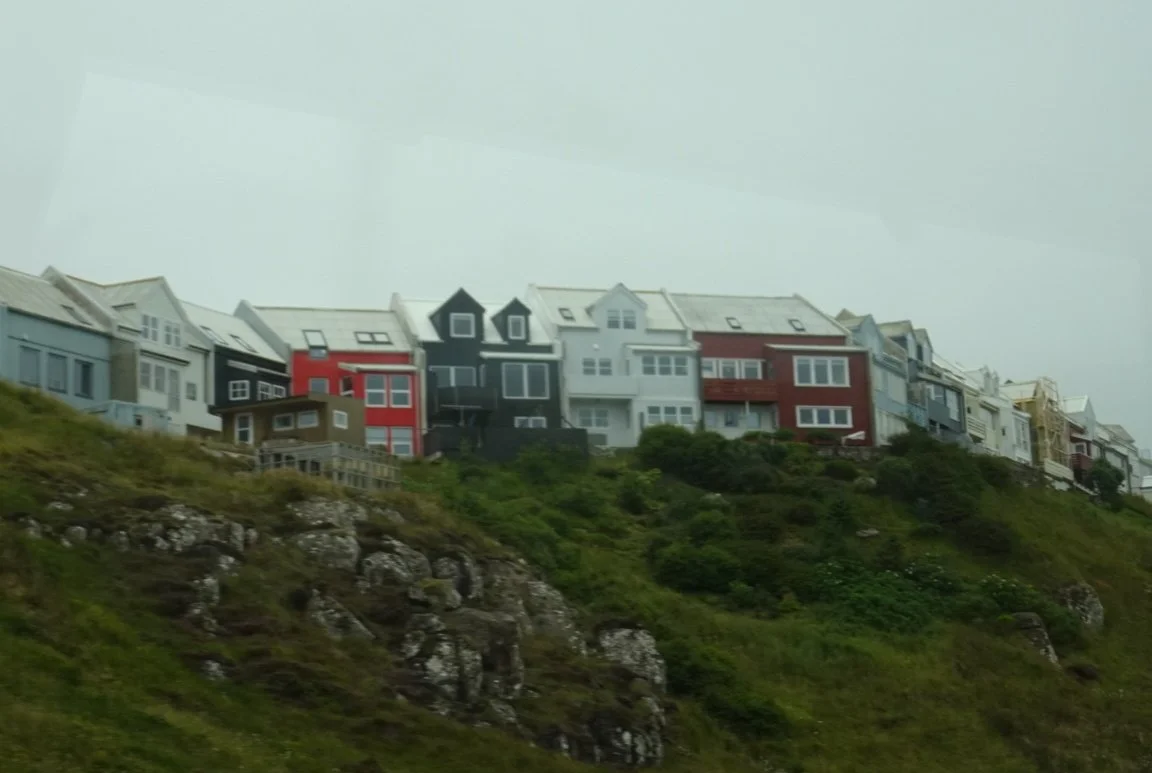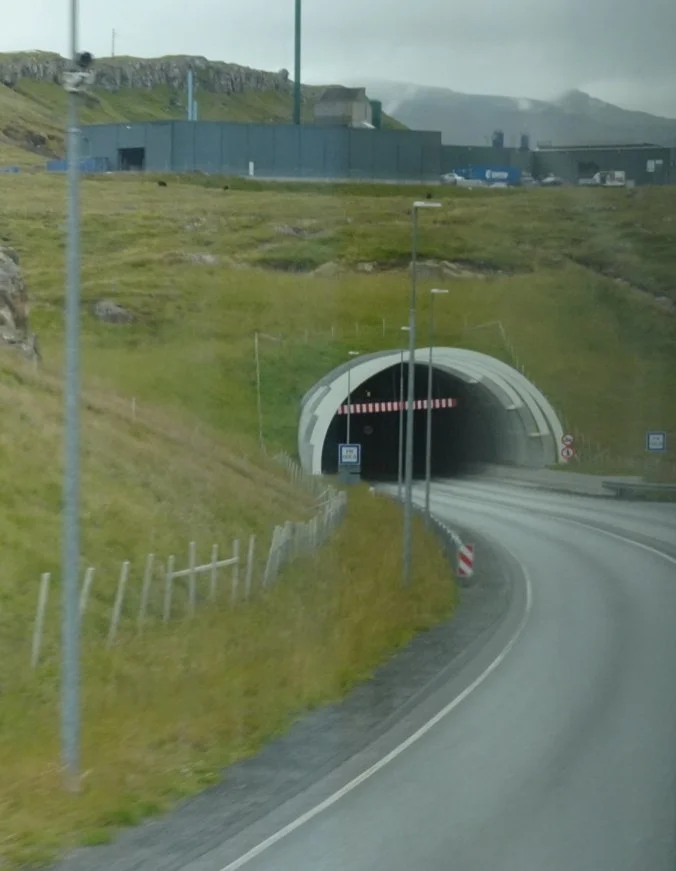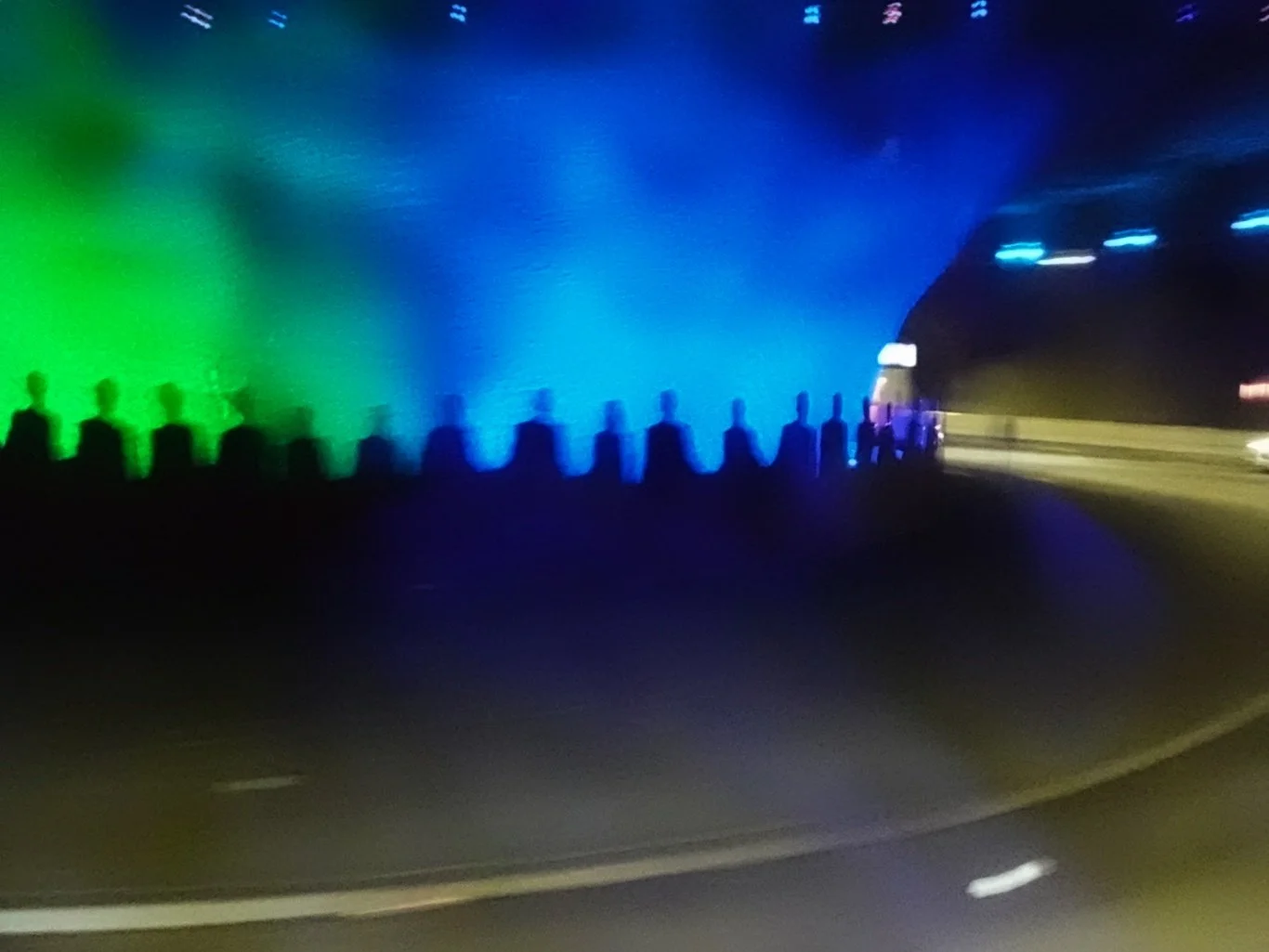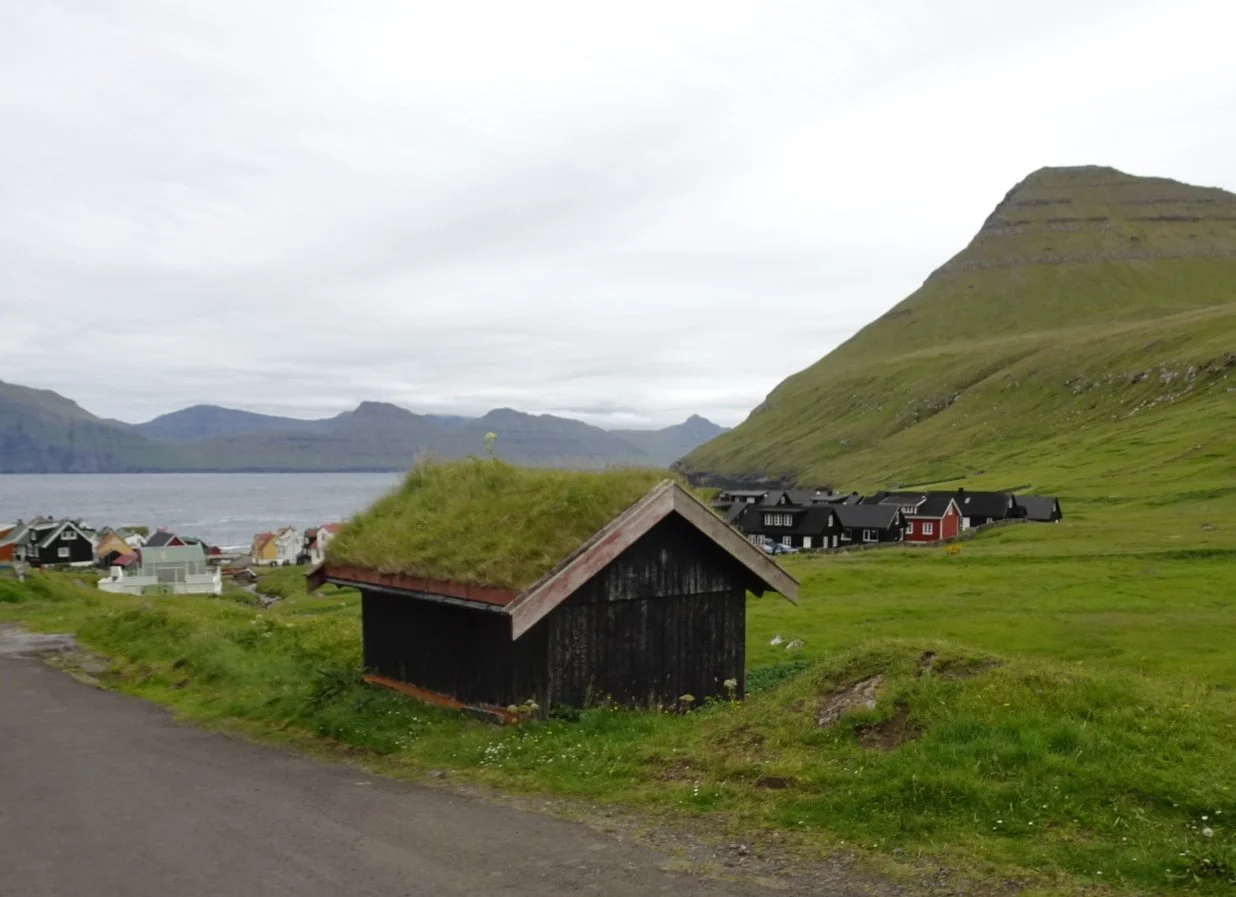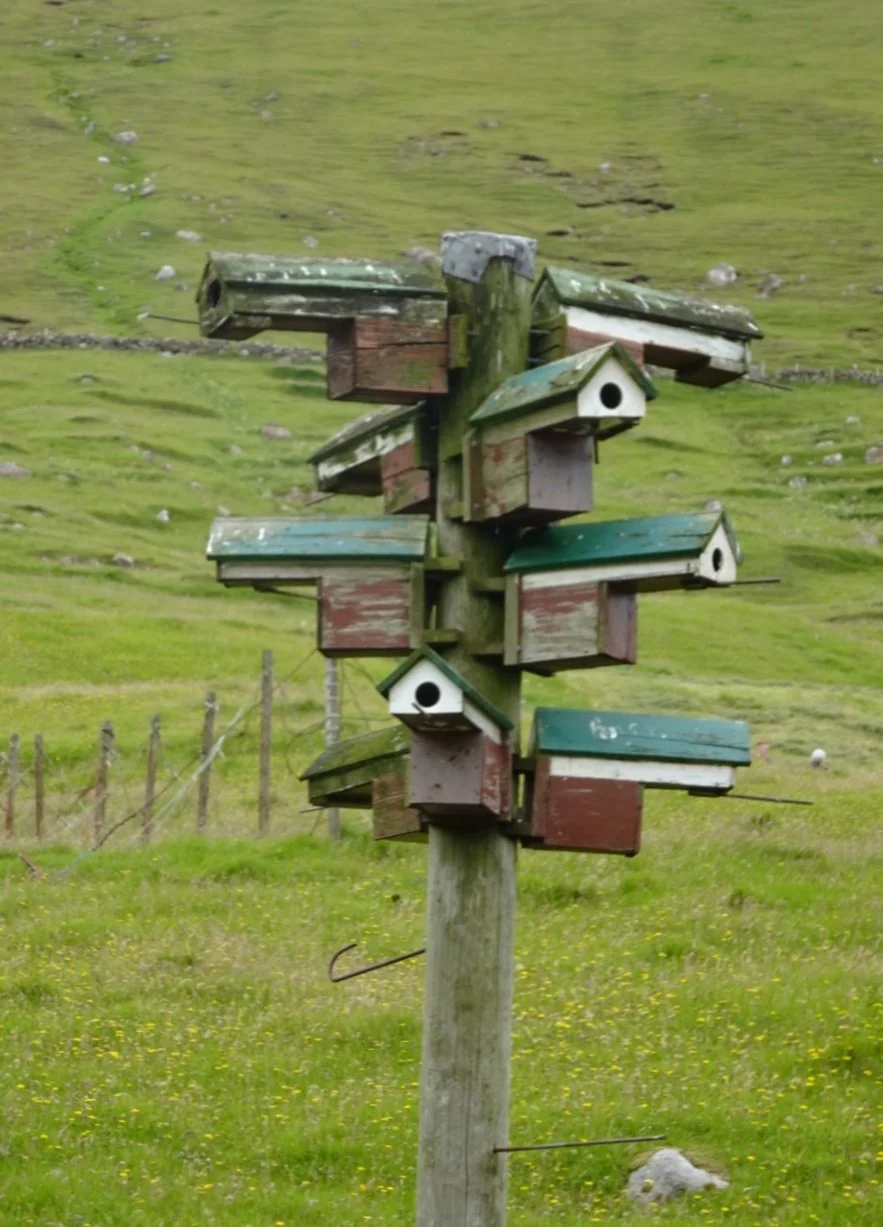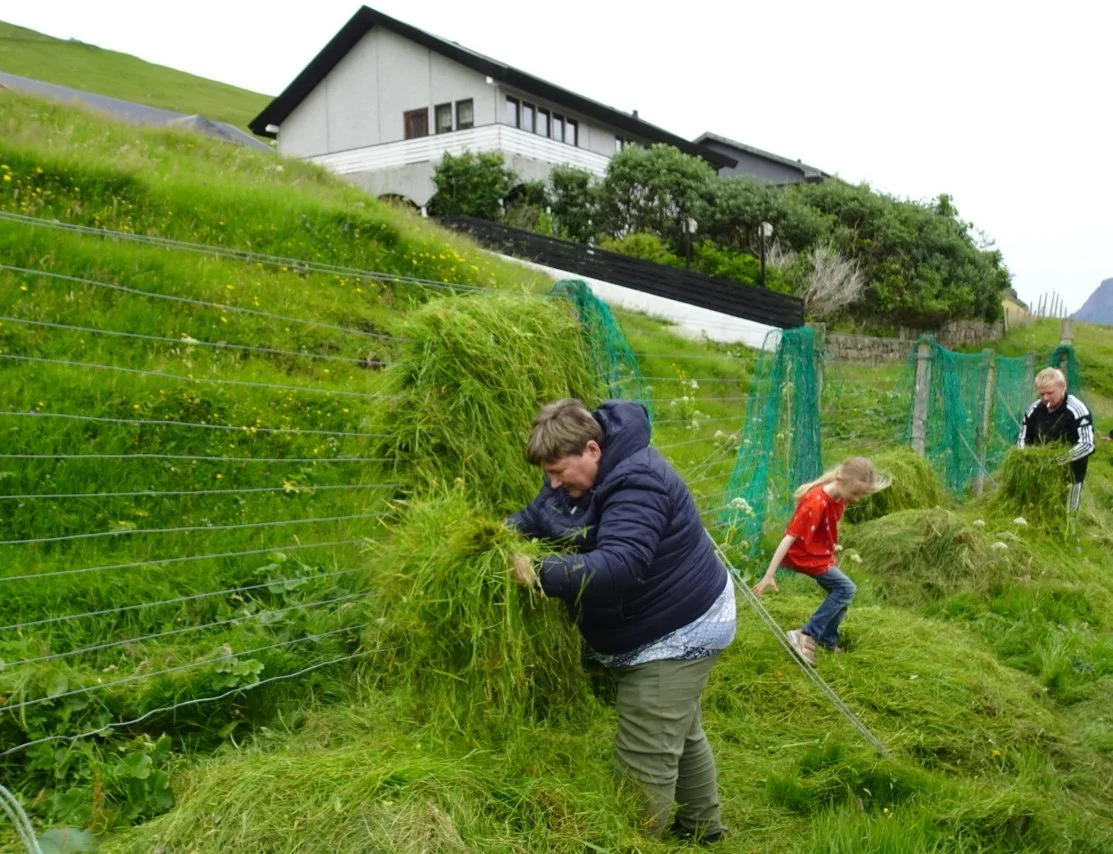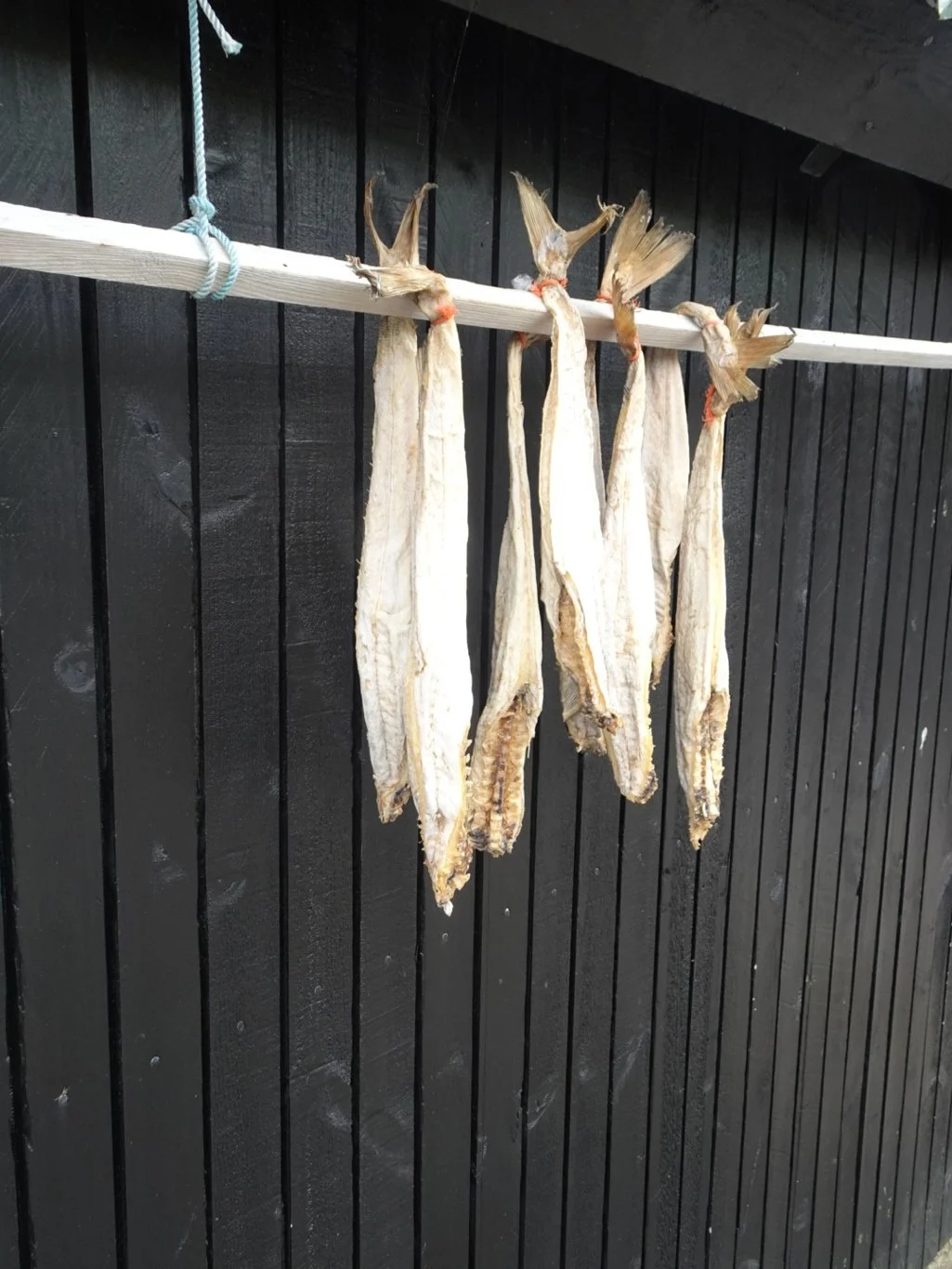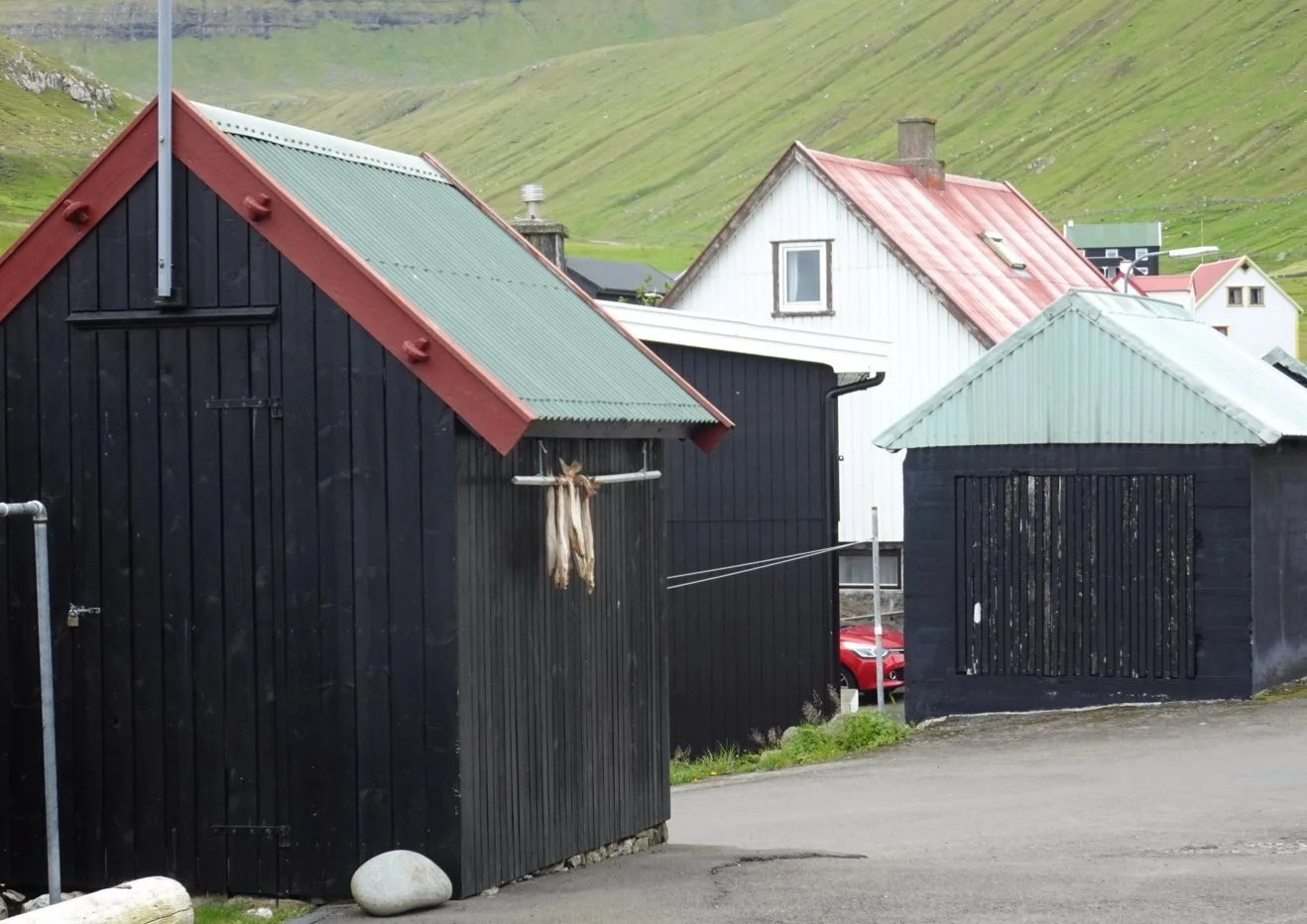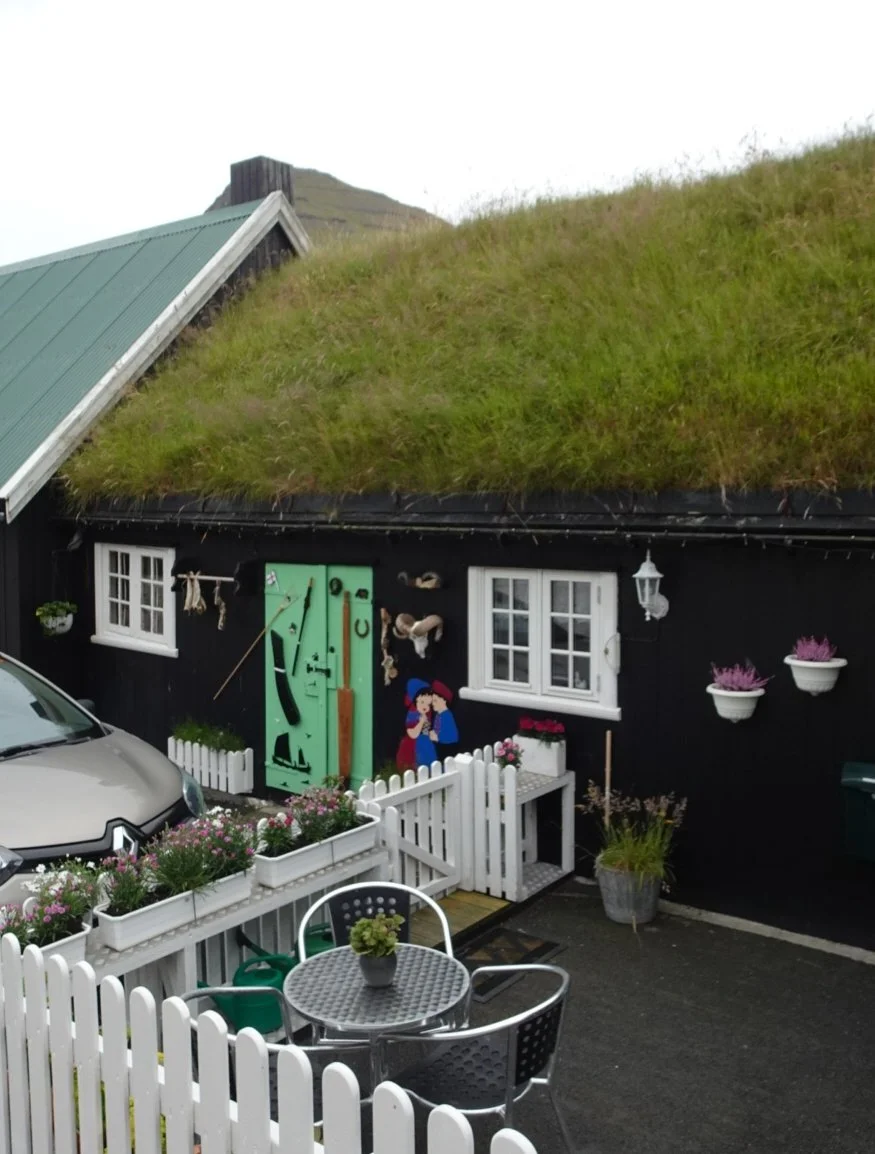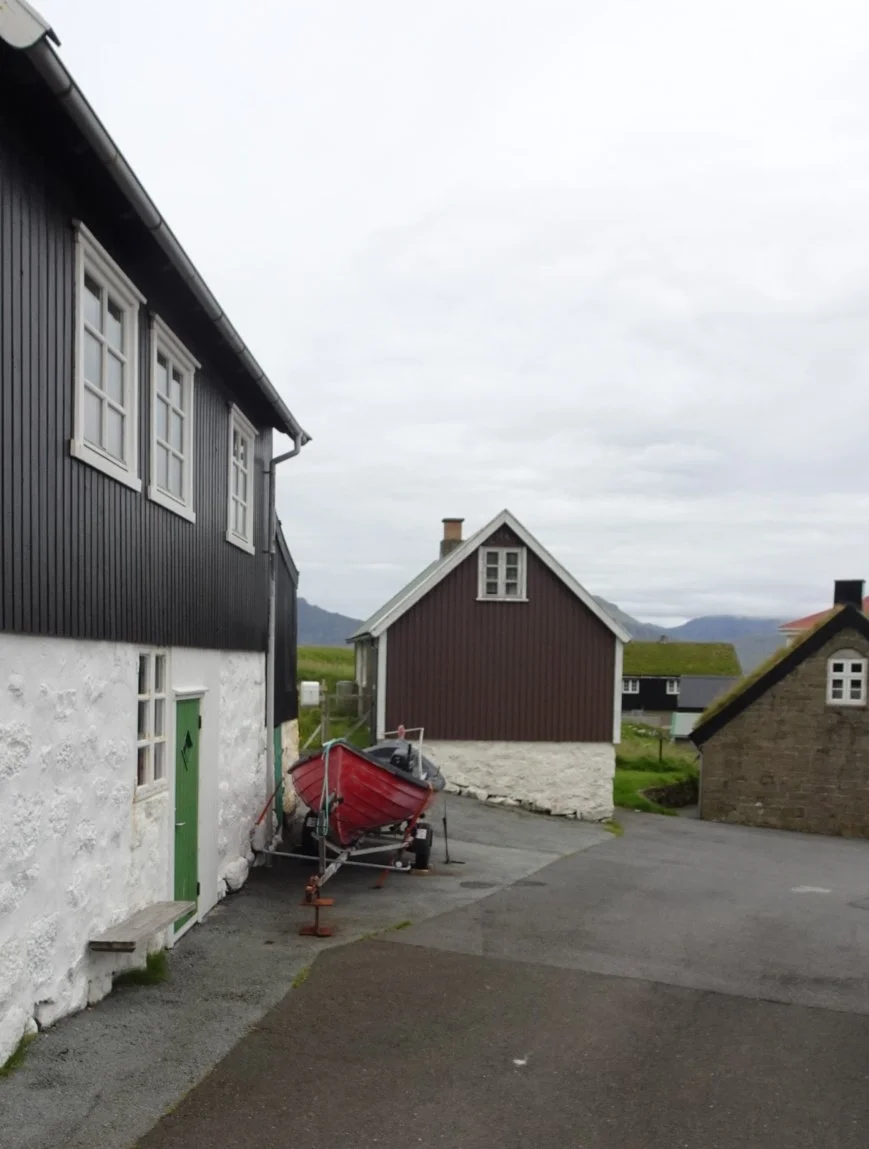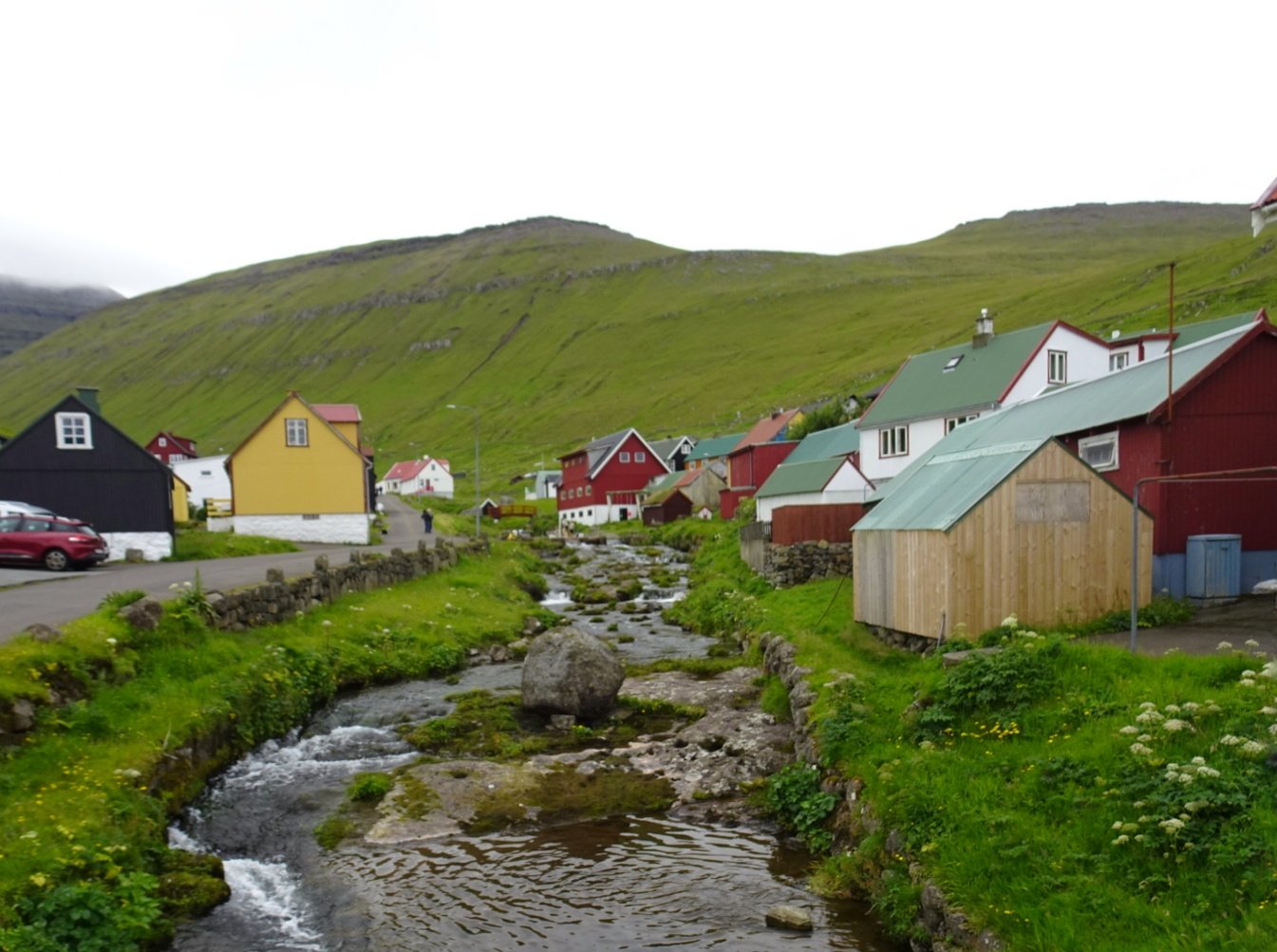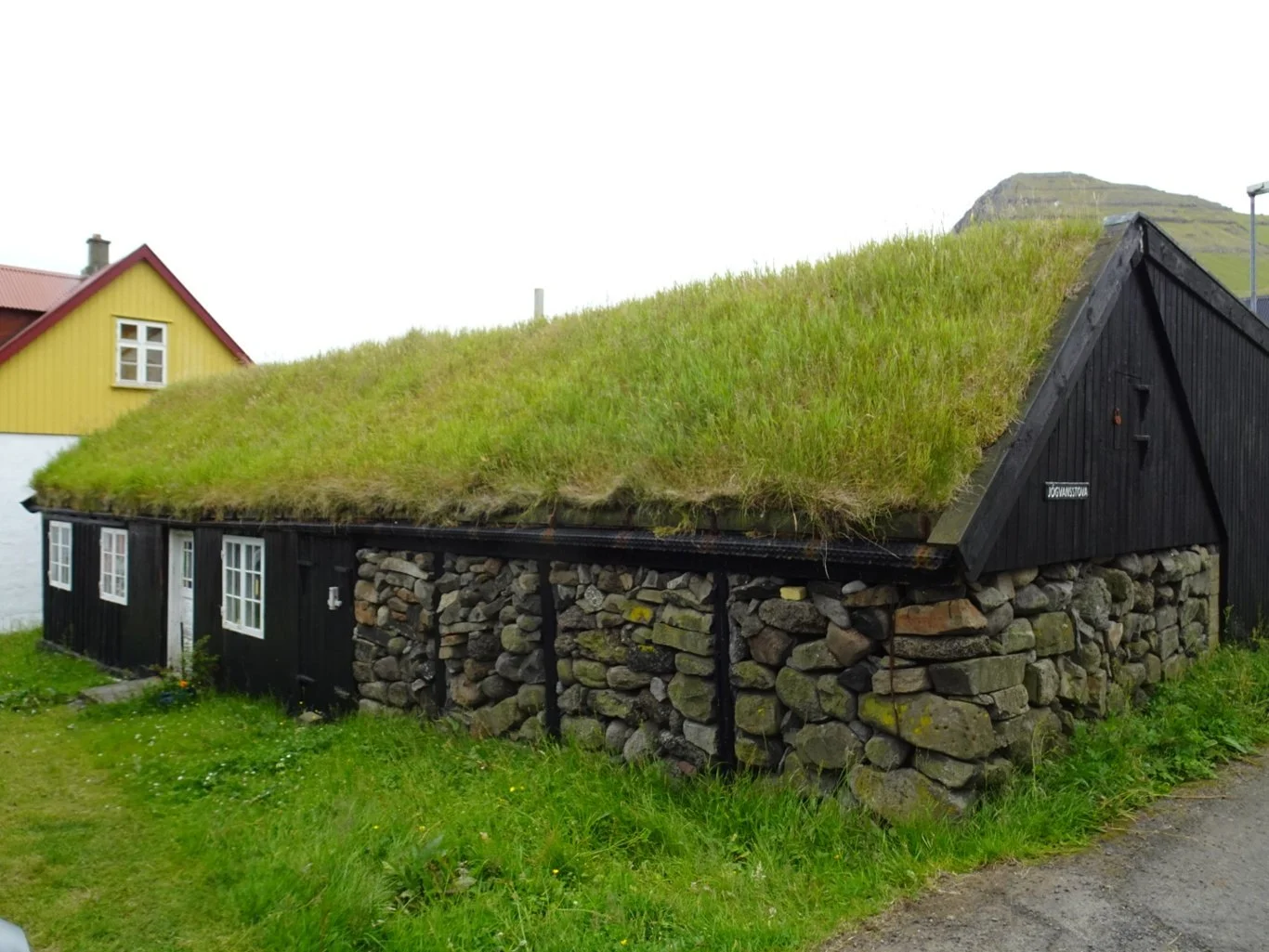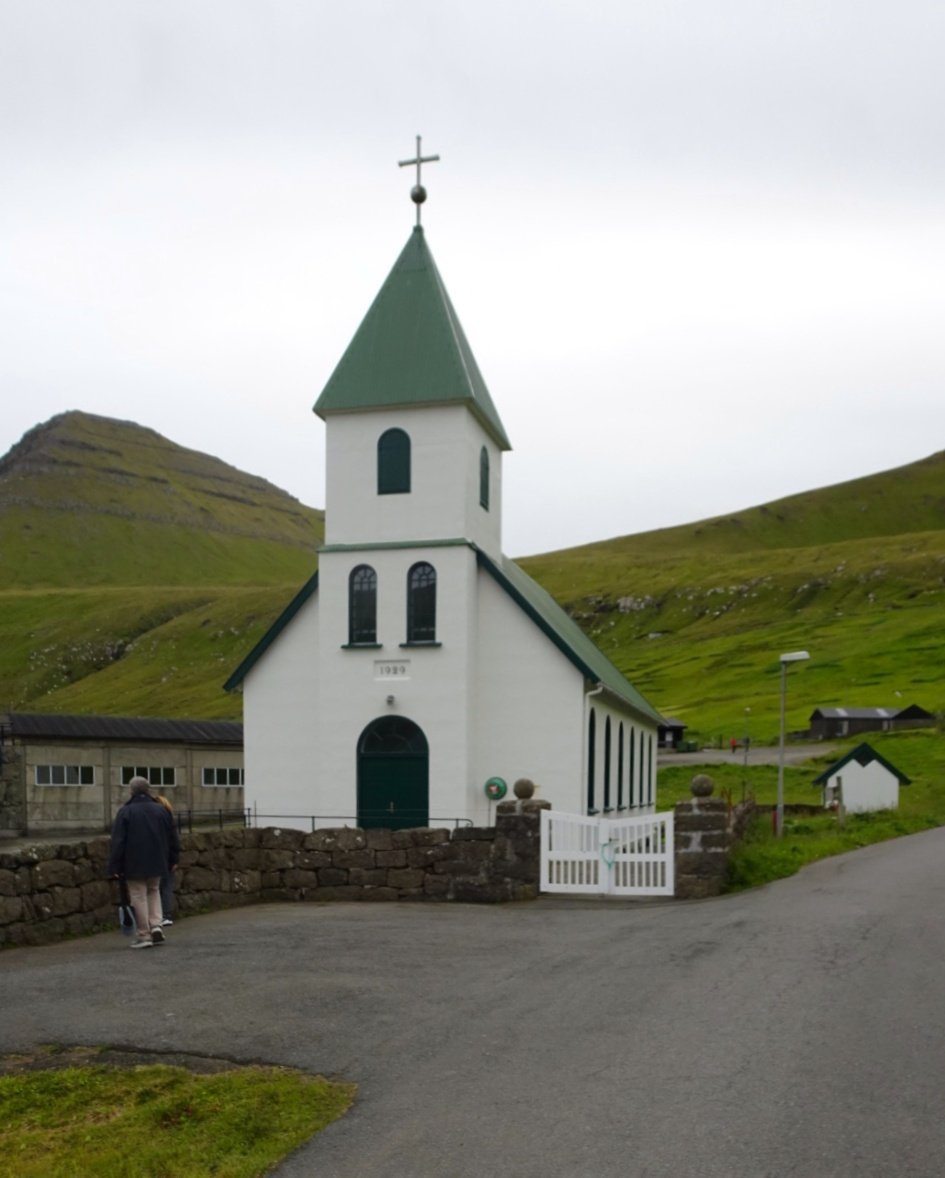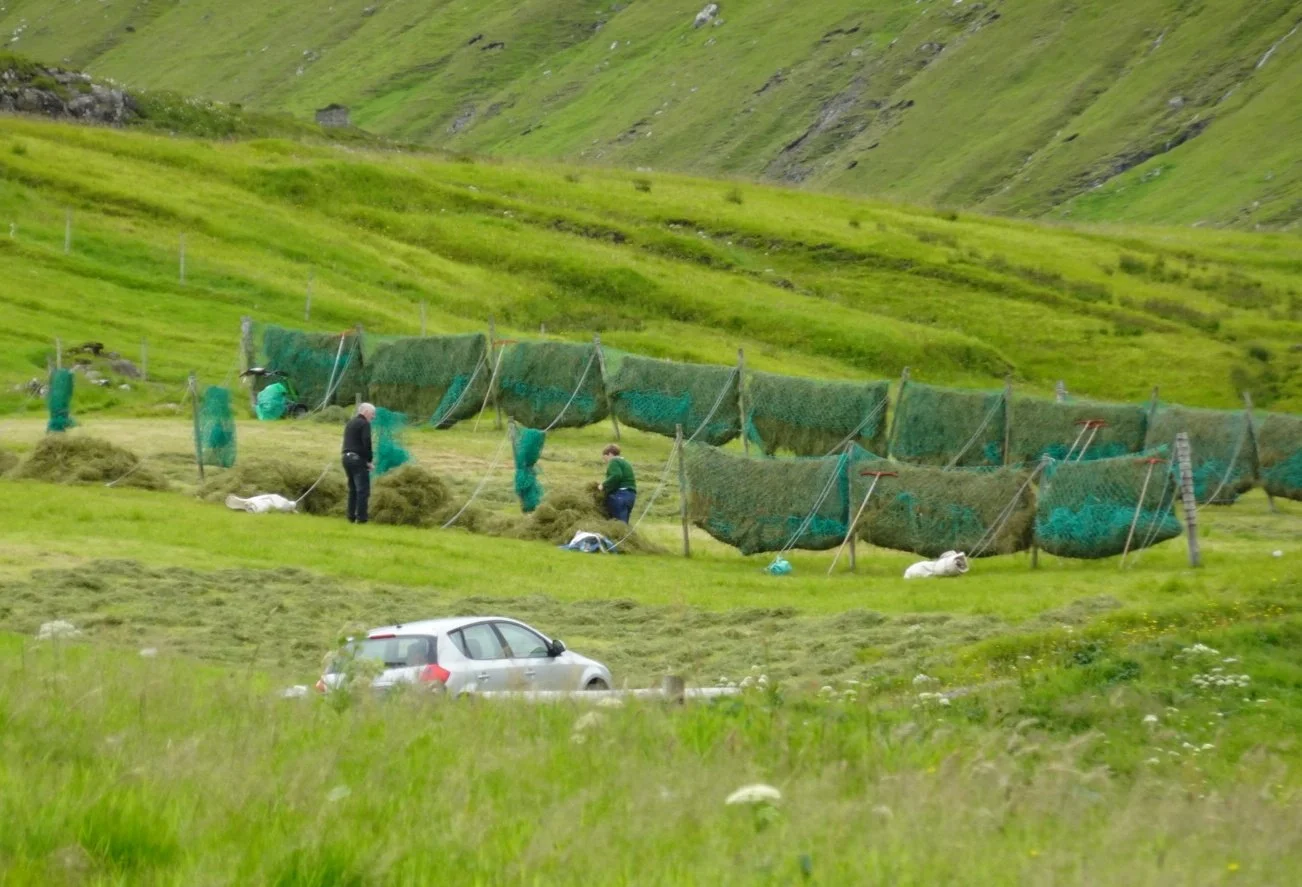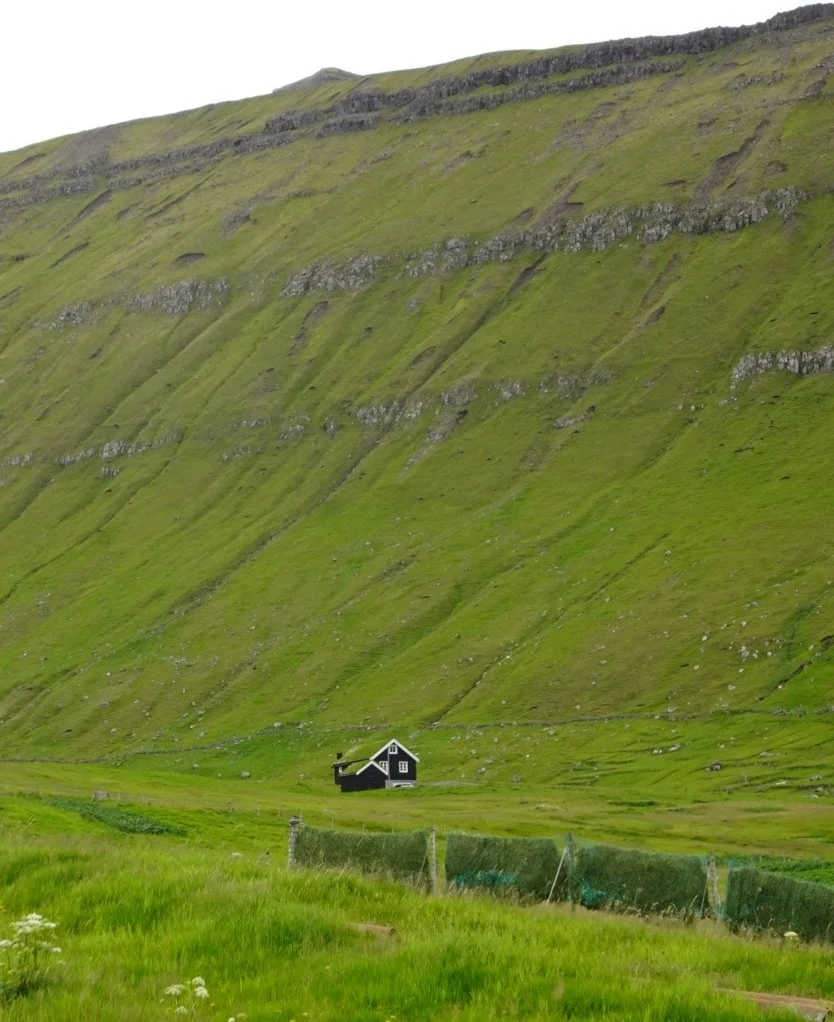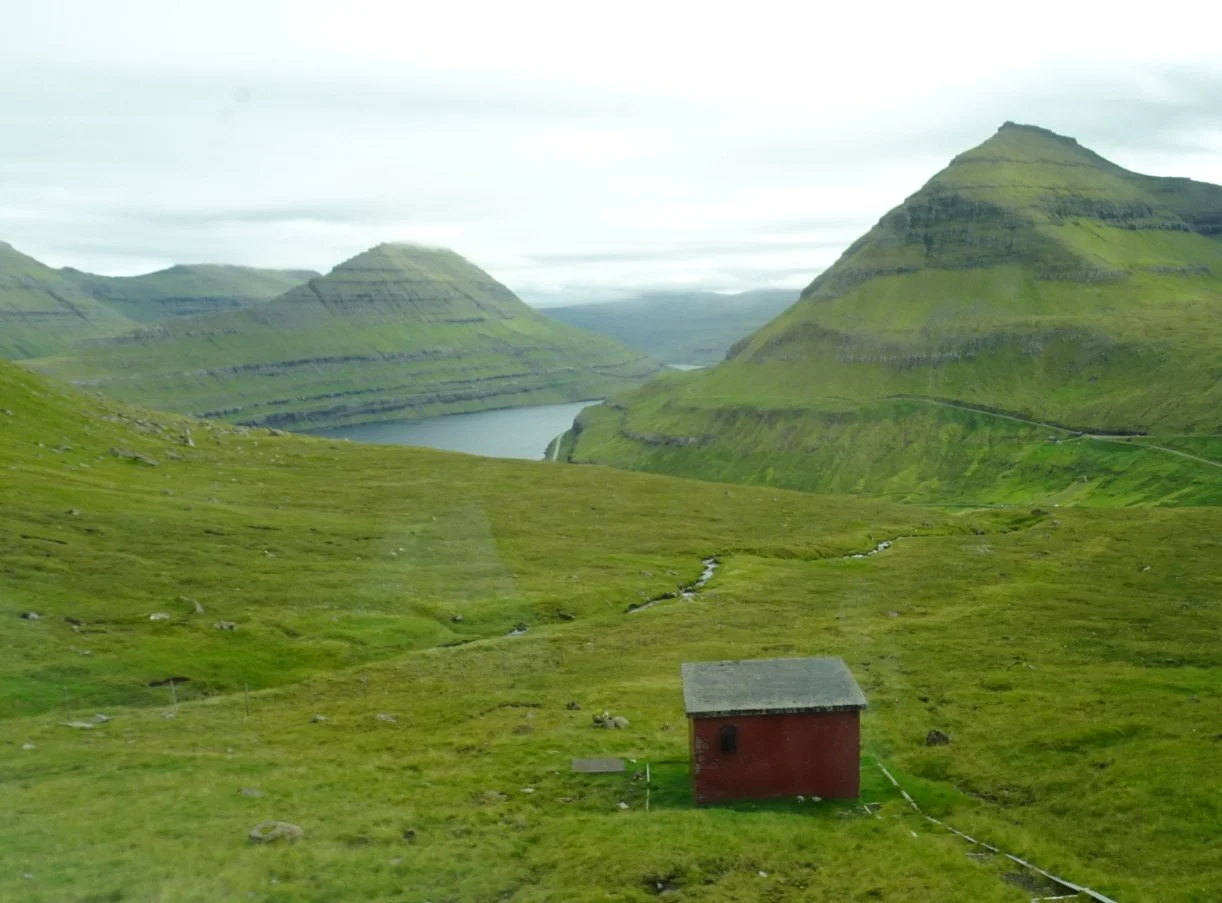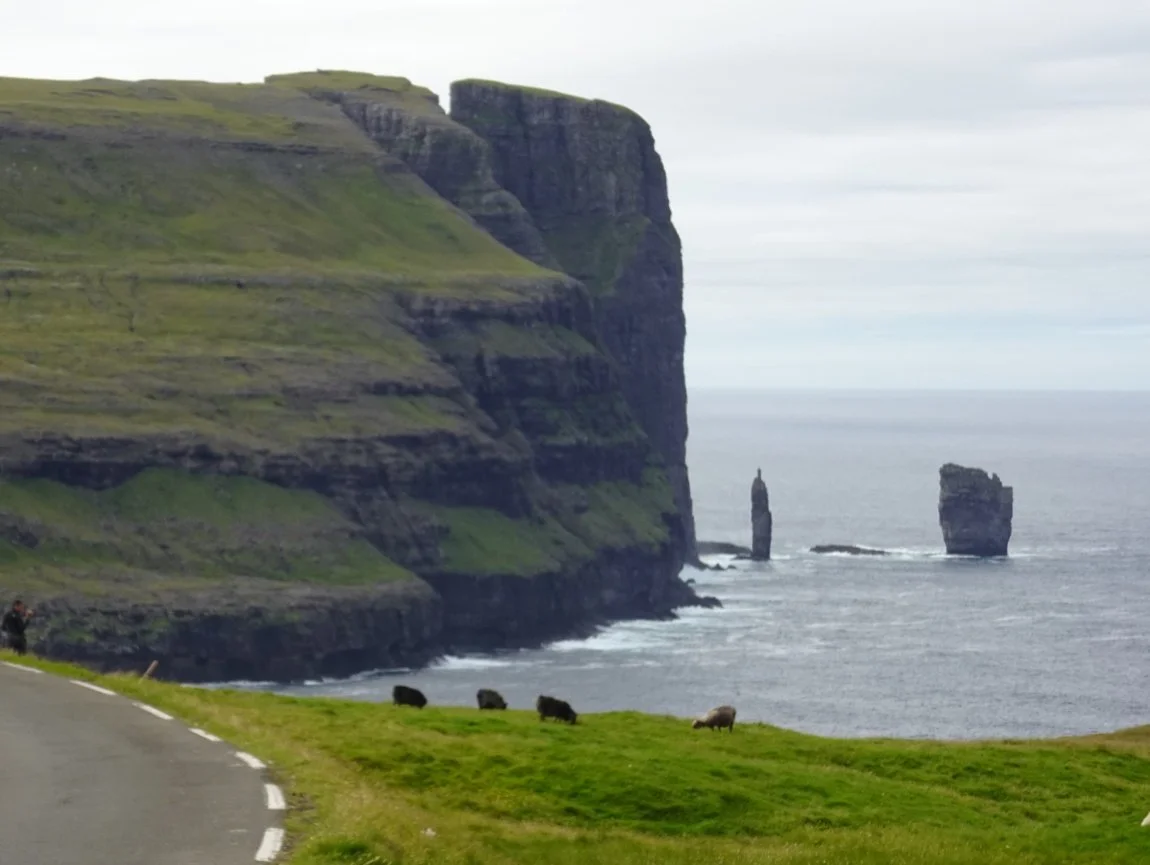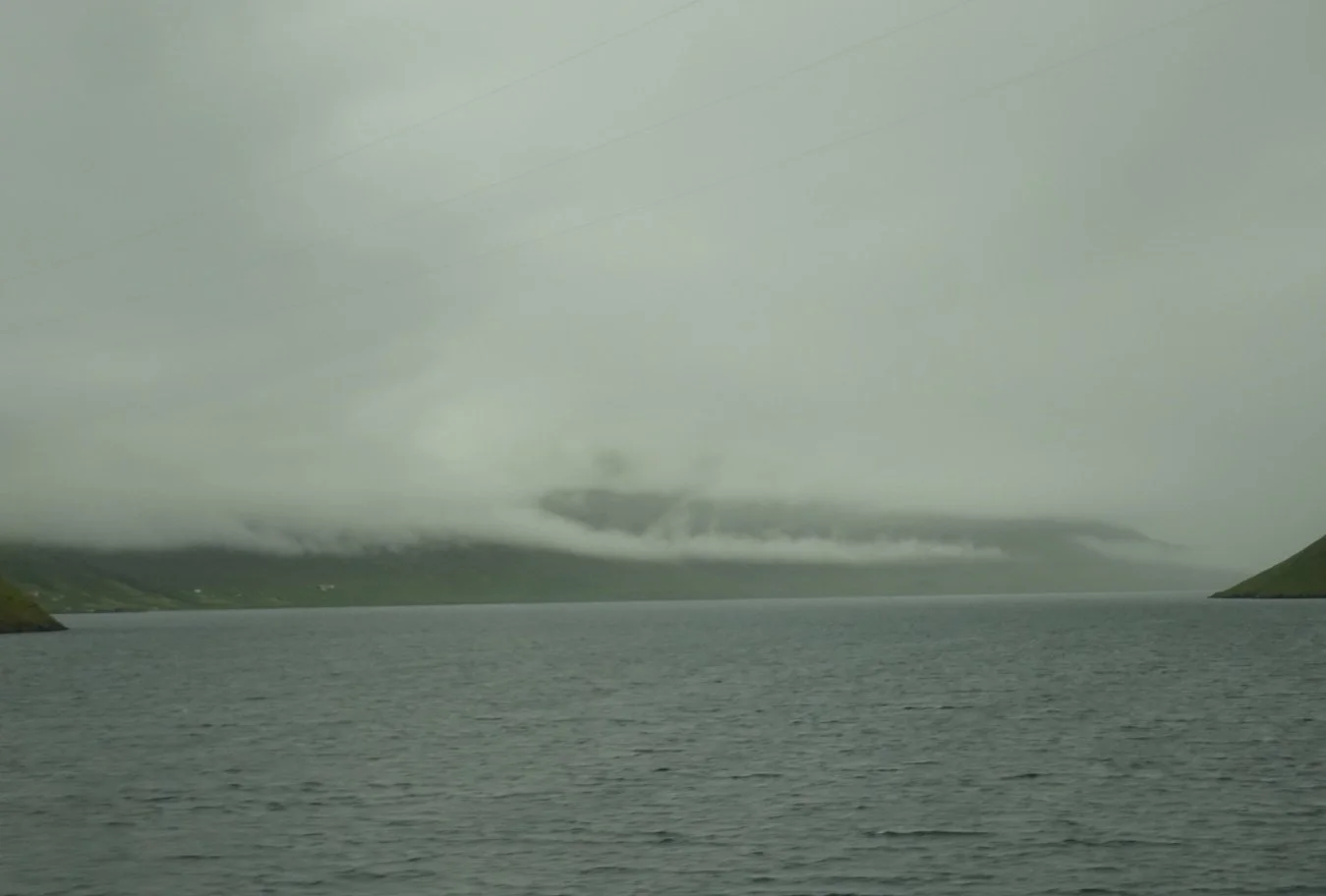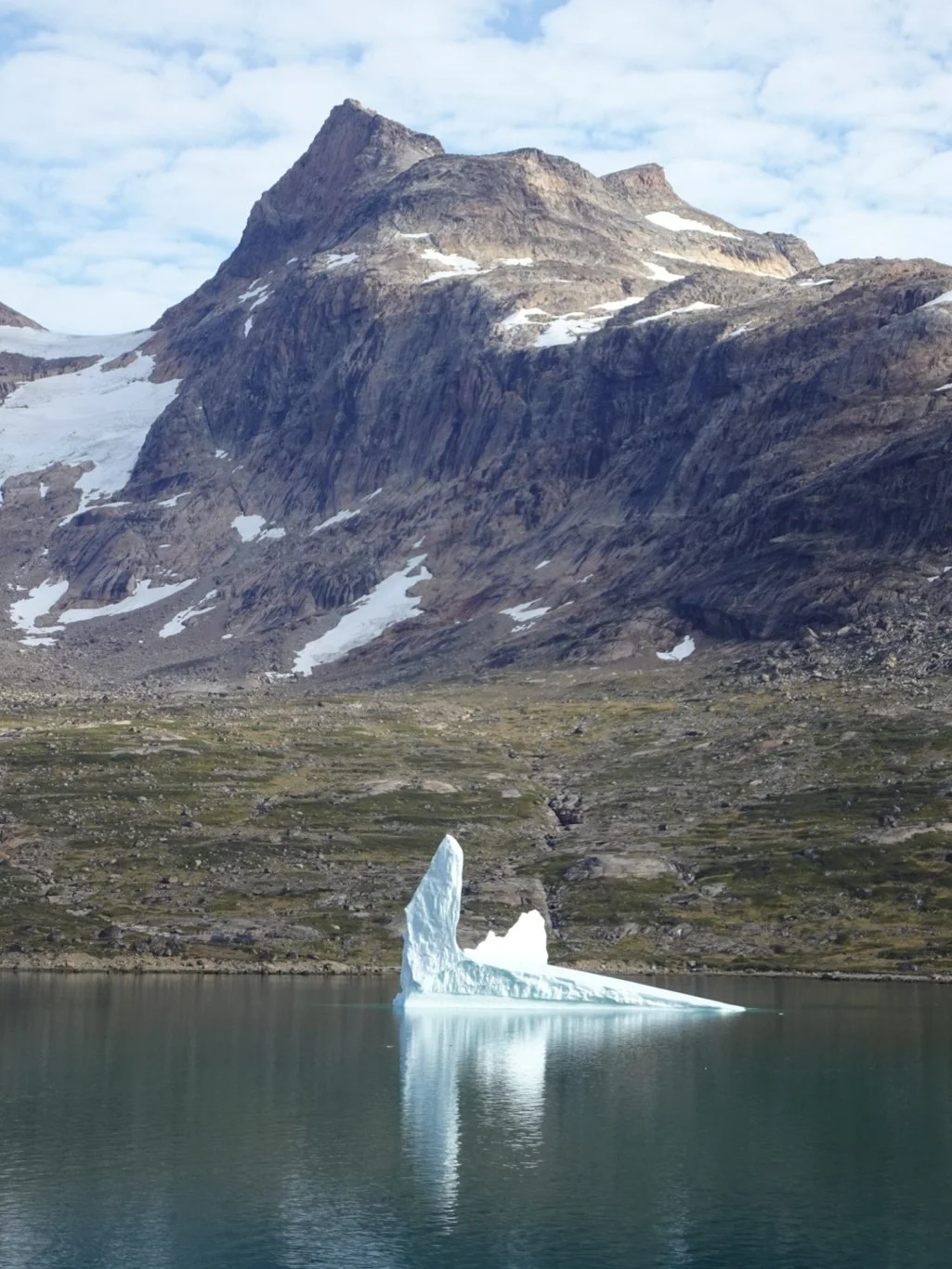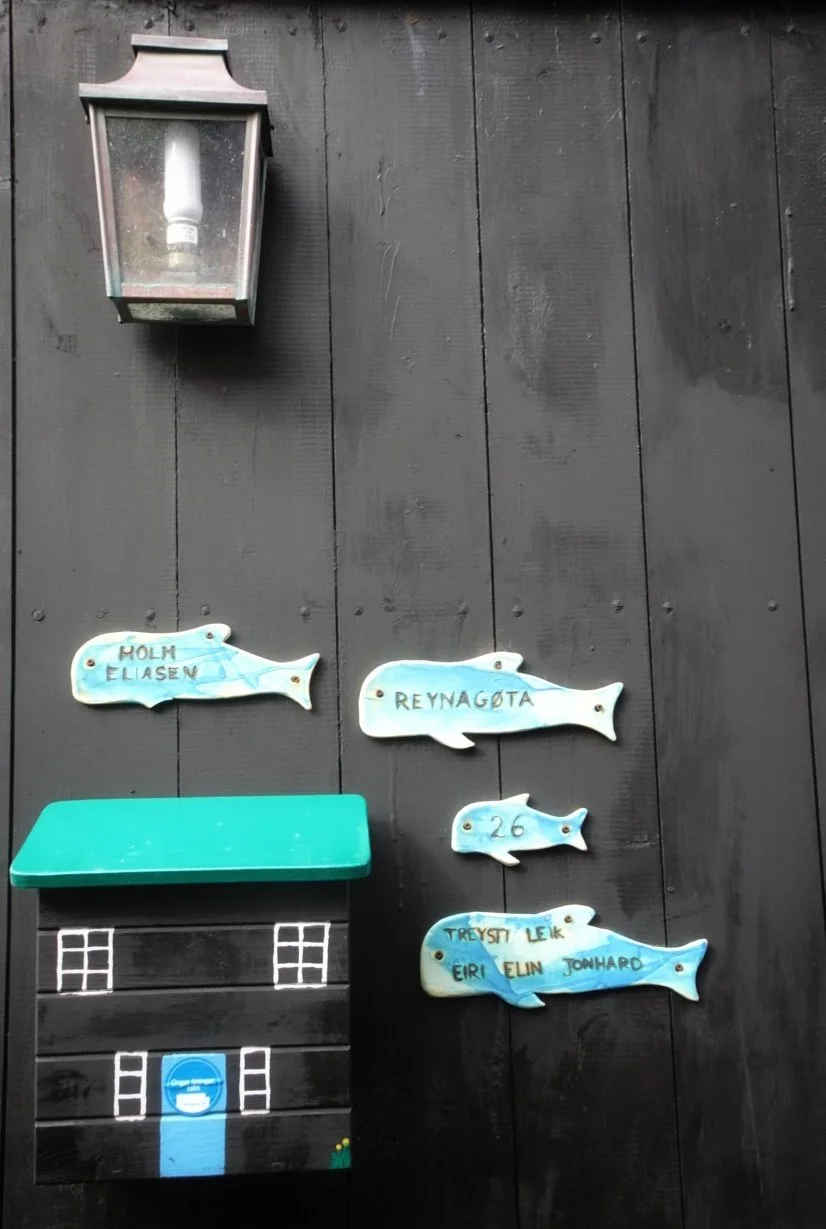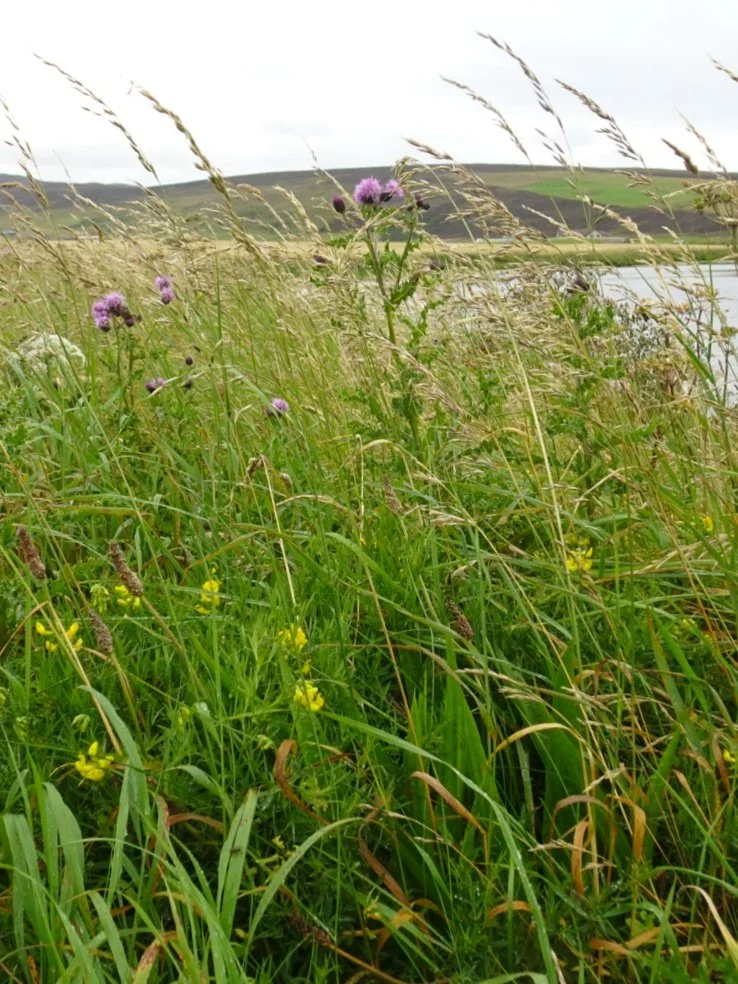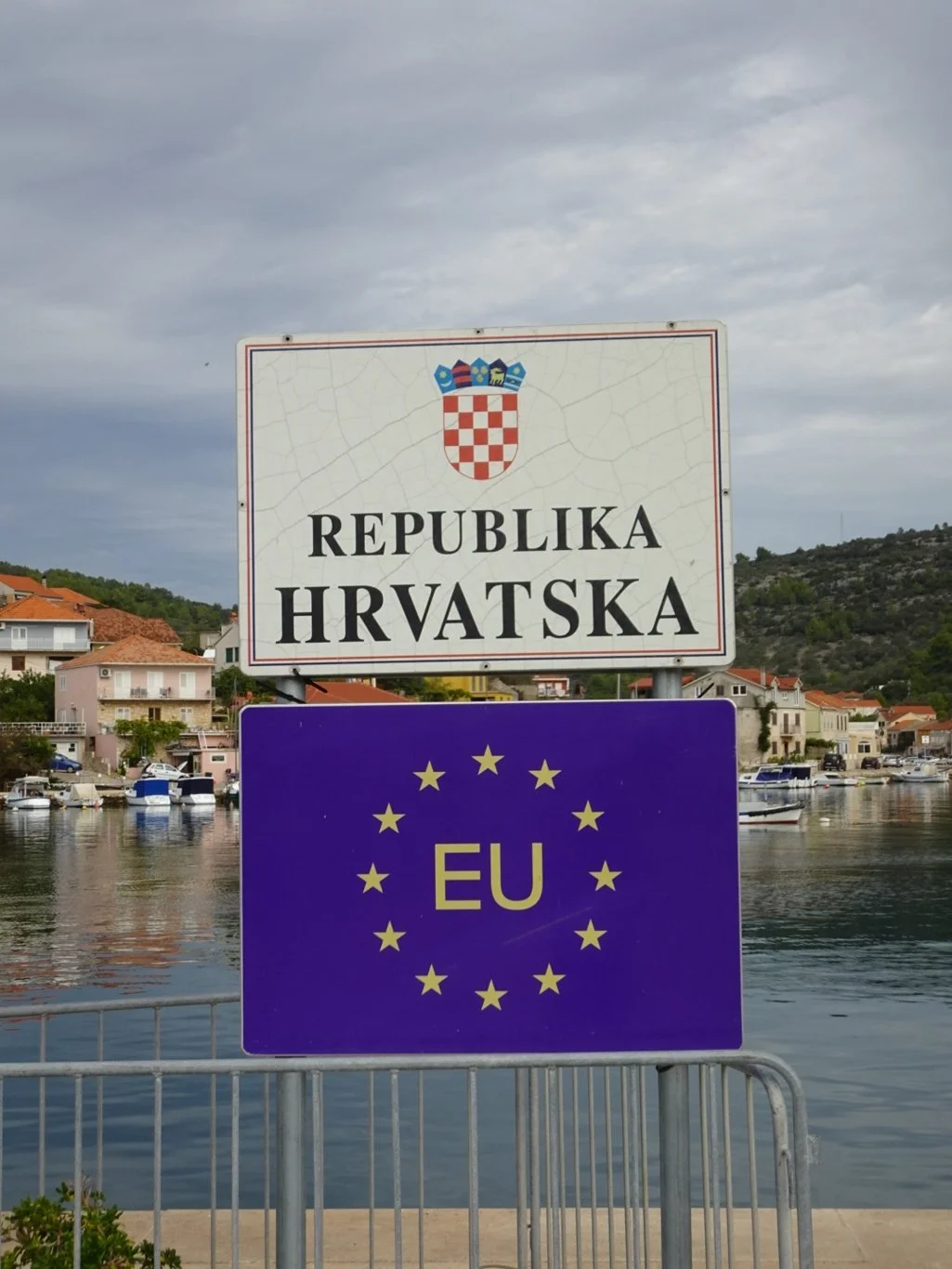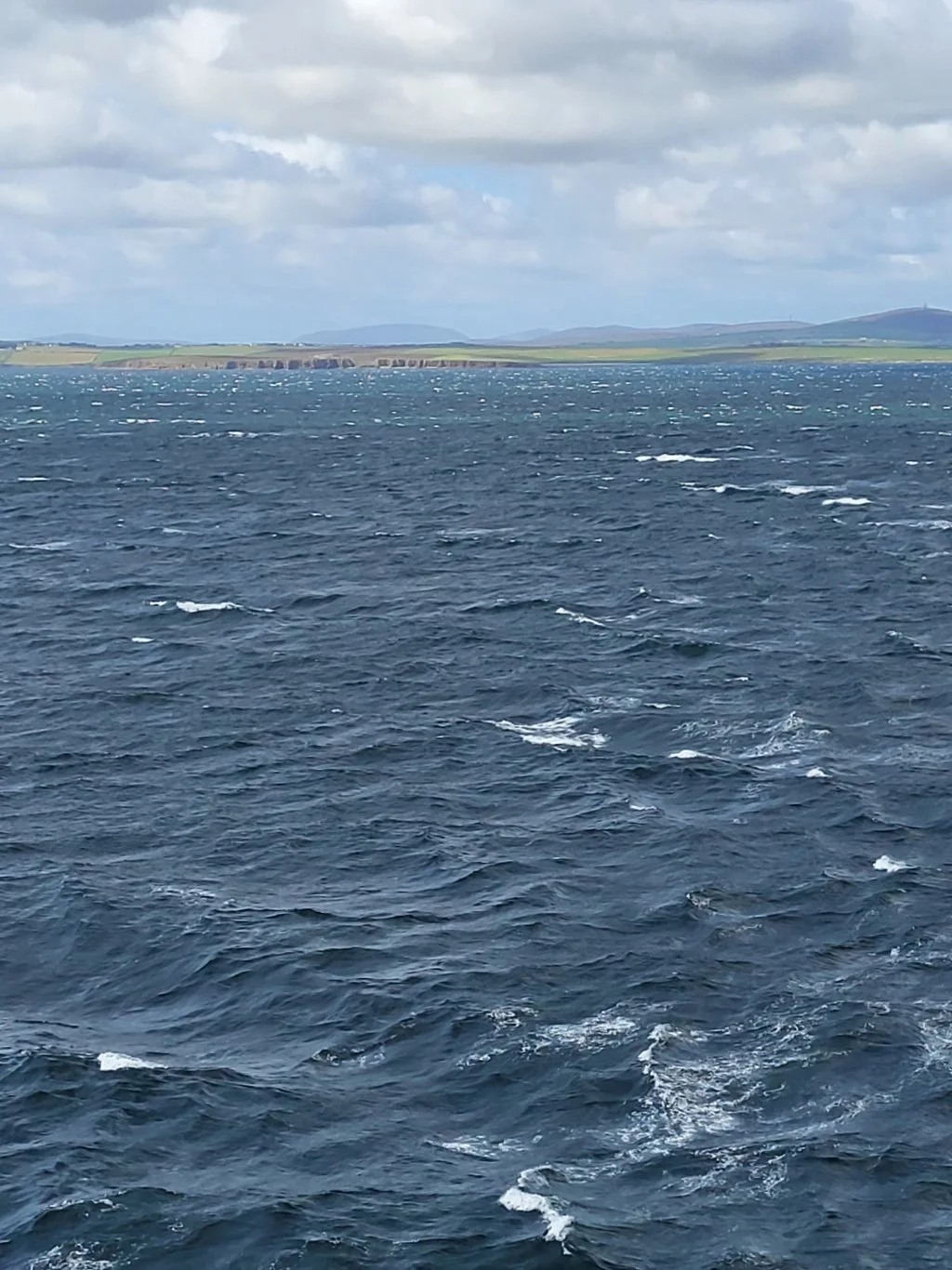Gjógv
Hard to pronounce, easy to love
“Gjógv gets its name from the 200-metre long sea-filled gorge running from the village into the sea. For centuries, the gorge was used as a landing place for local boats. With the steps leading down to the gorge, it is the perfect place to enjoy the dramatic sounds of the sea. With fewer than 30 inhabitants, Gjógv has an abundance of charm as well as spectacular hikes that offer stunning views of the North Atlantic and the surrounding islands.”
How to say Gjógv? Try ‘Jake’ and add a ‘v’!
Our afternoon tour would take us to the neighbouring island of Esturoy and this morning, whilst in the tourist office, we picked up a map of the island and noted one or two details about the places we’d visit. We were soon out of the centre of Torshavn and as we left the more modern suburbs I snapped a picture from the bus window of the houses on the ridge, standing shoulder to shoulder against the weather up there.
Our guide, Unn, explained that we would take the route to Eysturoy via the recently completed tunnel. It’s 11km long and costs a pretty hefty toll to use, though for many people, the shorter commute makes it worthwhile. As we drove into the darkness, we were told to watch out for the lights which would appear when we reached the half way spot. A little further along would be a roundabout, for the tunnel links to two sides of a long fjord on the island.
Sure enough, the coloured lights appeared as we approached the roundabout, which we circled twice to ensure everyone got a glimpse of the artwork in the centre. It’s a design created to depict the traditional Faroese circle dance and rather effective I thought - shame that our travel speed and the poor light levels don’t make for the best picture!
Once out on the other side, we headed for Gjógv, our main destination for the afternoon. As we drove, we caught sight of a few other small villages, each one filled with colourful houses clustered together.
Though there were some turf roofs here and there, the majority of homes had more conventional roof coverings. Driving into the village of Gjógv, we were invited to enjoy coffee and cake in the small hotel there before meeting up again at the church an hour or so later.
It proved no problem to spend that hour looking around this delightful place which had so many quirky little things to notice and to take photographs of.
As we’d driven here, Unn had pointed out people working in the fields, “hanging grass to dry”. Try as I might, I couldn’t quite see what they were doing but here, by the side of the road, a family were doing exactly that. they had cut the grass, had piled it alongside the fence and were now hanging it over the cross wires of the fence so that the wind could blow through and dry it. A different way of making hay! As we passed them, the woman looked up and we shared a smile. Would it be ok if I took a picture, I asked her? She nodded and carefully posed for me as she lifted the grass into the air. Hard work, I commented and she nodded in agreement, holding her back as she did so. Smiles and gestures of sympathy were all that was needed!
A little further on and we were amongst the village houses. Unn stood at the only road junction, pointing out the way to the gorge, from where it’s sometimes possible to see puffins.
Whilst my Hero set off to walk to the end of the pathway, I chose to spend time watching and snapping a few pictures of the houses here. In particular, I noticed that every one of them had a drying rail - not for clothes but for fish.
(I immediately thought back to that smelly street in town this morning and wondered…)
The gorge was spectacular and the rush of sea water impressive but today, there were no puffins. I watched as another group followed the pathway on the other side of the gorge uphill to the viewpoint. Even though there was a well maintained set of steps along the way, I’d rather them than me!
Just as we’d noticed this morning in Torshavn, people had been creative with their exterior decor adding personal touches alongside the fish drying rail.
Here too there was not only space for parking a car but for parking one’s boat too.
Further upstream, the gorge was less spectacular but rather more accessible and just like such places the world over was attracting the attention of families with youngsters. Small groups of them were dressed in wetsuits and having fun by the water’s edge and a few small boys were messing about in the water, fishing maybe.
Though most of the houses appeared fairly modern, there were some more traditional structures too.
It didn’t take us long to be down by the church and we had time to continue down to the water’s edge.
Waves and water like this can be quite mesmerising and we stood for a while just enjoying the spectacle of crashing waves. Of course, it would be altogether different if we’d had to set off in a little boat and catch our supper.
Or, if we’d needed to hang more grass out to dry. We watched as another family was busily gathering in the mown grass over on the other side of the village - clearly, this is the week for getting this process complete. As we drove off, we found ourselves needing to wait for the driver of the car with the trailer attached to load up several bundles of grass and drive off in front of us. He’d gone no further than a few yards when one of the bundles dropped off the trailer, causing him to leap out of the car and to run and pick it up. He left it to the side of the road and will surely come back and collect it later. No worries about anyone else picking it up…there’s nobody else around to do that really!
The landscape around here was both gentle and rather bleak at the same time. Unn had told us that the weather here isn’t that severe - the winter temperature doesn’t go much below about 9C and snow isn’t much of an issue. But the summer temperature doesn’t go much above 11C either - a strangely cool year round climate. (As we were in the village, I’d noticed a small boy dressed in shorts and a balaclava hood!)
The views were spectacular as we drove back towards Torshavn along a different route.
We stopped for photos at the sea stacks Risin and Kellingin and listened as Unn told us the story
From there we drove via Eiði towards the bridge which would take us back to Torshavn. Unn pointed the bridge out and encouraged photographs. “This is the bridge over the Atlantic Ocean!” she said.
We had one more photo stop to make but as the weather came in over the next ten or fifteen minutes, Unn declared we’d skip that idea. We drove alongside the fjord towards Torshavn then, keeping an eye open for one of the four whales which have been seen in the area during the last week. Hopefully some of the families and groups of photographers would have more luck than we did.
The driver had his windscreen wipers going as we pulled into the port area and we counted our blessings that we’d been able to spend a full day here without a drop of rain. The Norge had already sailed and we were about to leave too, but not without a fondness for the spirit of the Faroe Islands, for the people and the fascinating things we’d seen.
Another great day!








